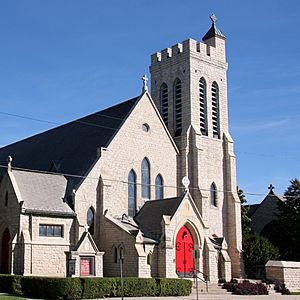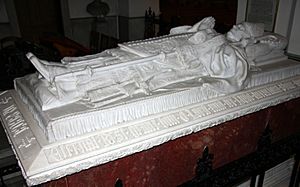St. Paul's Cathedral (Fond du Lac, Wisconsin) facts for kids
St. Paul's Cathedral is a very important church in Fond du Lac, Wisconsin. It is the main church for the Episcopal Diocese of Fond du Lac. This means it is where the bishop of the diocese has his official church.
Contents
Early Years: 1848-1865
The first Episcopal church services in Fond du Lac happened in 1842. Reverend Richard Fish Cadle led these early services. Later, in 1845, Bishop Jackson Kemper visited the growing village. He held services at the home of Governor Nathaniel P. Tallmadge.
On September 3, 1848, St. Paul's Church was officially started. Reverend Joshua Sweet was the Episcopal priest for the village. Many well-known families in the area joined the new church. Some of their names, like Doty and Tallmadge, are now street names in Fond du Lac.
At first, these church members met in different places. Then, in 1851, they built their first church. It was a wooden building located at Follett and Bannister (Macy) streets.
Growing Stronger: 1866-1913
By 1866, the church community had grown a lot. They moved to their current spot on West Division Street. There, they built a new church made of stone. Around this time, people started working to create a new diocese. A diocese is a church district led by a bishop. This new diocese would be formed from the Fond du Lac area.
By 1870, Fond du Lac was the second largest city in Wisconsin. The new Diocese of Fond du Lac was officially created in 1875. Soon after, Bishop John Henry Hobart Brown declared St. Paul's Church as the main church for the diocese. It was chosen partly because it was a 'free-church', meaning it didn't charge for pews.
In January 1884, the stone church building sadly burned down. But a new church was built in its place, which is the building you see today. From 1889 to 1912, Bishop Charles Chapman Grafton worked hard to finish the inside of the church.
He added a pulpit, which is a raised stand for sermons. This pulpit was made by a local stone carver named Robert Powrie. A beautiful brass eagle lectern was also added. This is a stand used to hold the Bible during readings.
Between 1893 and 1894, amazing carvings were brought from Munich, Germany. These carvings were in the Victorian style. They included figures of the twelve Apostles, St. Paul, and twenty-five angels.
After Bishop Grafton passed away, Reverend Bernard Iddings Bell became the first Dean of the cathedral. He served until 1917. He was known for his strong beliefs and writings. He often wrote for The Living Church magazine. He also gained national attention for his book, Right and Wrong After the War (1918).
Chapel of St. Michael the Archangel
Bishop Grafton had a special wish: he wanted to be buried in the cathedral. So, in the year after he passed away on August 30, 1912, a special area was redone. This area is now called the Chapel of St. Michael the Archangel.
His burial site has a white marble and red porphyry sarcophagus. A sarcophagus is a stone coffin. On top of it is a life-size statue of the bishop. The chapel became his permanent burial place on August 30, 1913.
See also
- List of the Episcopal cathedrals of the United States
- List of cathedrals in the United States
- Bernard Iddings Bell, Dean of St. Paul's Cathedral, 1912-1919
- Albert J. duBois, canon pastor 1935-1938




